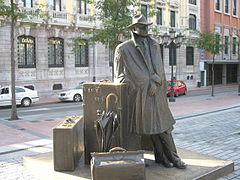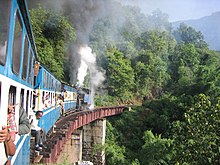Travel: Difference between revisions
No edit summary |
Adampescod (talk | contribs) |
||
| Line 33: | Line 33: | ||
== History of travel == |
== History of travel == |
||
{{sectstub|date=August 2016}} |
{{sectstub|date=August 2016}} |
||
While early travel tended to be slower, more dangerous, and more dominated by trade and migration, cultural and technological advancements have tended to mean that travel has become easier and more accessible<ref>[https://www.gapyear.com/history-of-travel/ "A Brief Visual History of Travel"]</ref>. The evolution of technology such as [[horse tack]] and [[High-speed rail | bullet train]]s has contributed to this trend. |
|||
While travel in the [[Middle Ages]] offered hardships and challenges, it loomed large in the economy and in society. The [[wholesaling | wholesale sector]] depended (for example) on [[merchants]] dealing with/through [[Caravan (travellers) | caravan]] or sea-voyagers, end-user [[retailing]] often demanded the services of many itinerant [[peddler]]s wandering from village to hamlet, [[gyrovague]]s and wandering [[friar]]s brought [[theology]] and [[pastoral care | pastoral support]] to neglected areas, [[travelling minstrel]]s practised the [[Never Ending Tour | never-ending tour]], and armies ranged far and wide<ref> |
While travel in the [[Middle Ages]] offered hardships and challenges, it loomed large in the economy and in society. The [[wholesaling | wholesale sector]] depended (for example) on [[merchants]] dealing with/through [[Caravan (travellers) | caravan]] or sea-voyagers, end-user [[retailing]] often demanded the services of many itinerant [[peddler]]s wandering from village to hamlet, [[gyrovague]]s and wandering [[friar]]s brought [[theology]] and [[pastoral care | pastoral support]] to neglected areas, [[travelling minstrel]]s practised the [[Never Ending Tour | never-ending tour]], and armies ranged far and wide<ref> |
||
Revision as of 14:28, 17 May 2017

Travel is the movement of people between relatively distant geographical locations, and can involve travel by foot, bicycle, automobile, train, boat, bus, airplane, or other means, with or without luggage, and can be one way or round trip.[1][2] Travel can also include relatively short stays between successive movements.
Etymology
The origin of the word "travel" is most likely lost to history. The term "travel" may originate from the Old French word travail, which means 'work'. [3] According to the Merriam Webster dictionary, the first known use of the word travel was in the 14th century. It also states that the word comes from Middle English travailen, travelen (which means to torment, labor, strive, journey) and earlier from Old French travailler (which means to work strenuously, toil). In English we still occasionally use the words "travail", which means struggle. According to Simon Winchester in his book The Best Travelers' Tales (2004), the words "travel" and "travail" both share an even more ancient root: a Roman instrument of torture called the tripalium (in Latin it means "three stakes", as in to impale). This link may reflect the extreme difficulty of travel in ancient times. Today, travel may or may not be much easier depending upon the destination you choose (e.g. Mt. Everest, the Amazon rainforest), how you plan to get there (tour bus, cruise ship, or oxcart), and whether you decide to "rough it" (see extreme tourism and adventure travel). "There's a big difference between simply being a tourist and being a true world traveler", notes travel writer Michael Kasum. This is, however, a contested distinction as academic work on the cultures and sociology of travel has noted.[4]
Purpose and motivation

Reasons for traveling include recreation,[5] tourism[5] or vacationing,[5] research travel[5] for the gathering of information, for holiday to visit people, volunteer travel for charity, migration to begin life somewhere else, religious pilgrimages[5] and mission trips, business travel,[5] trade,[5] commuting, and other reasons, such as to obtain health care[5] or waging or fleeing war or for the enjoyment of traveling. Travel may occur by human-powered transport such as walking or bicycling, or with vehicles, such as public transport, automobiles, trains and airplanes.
Motives to travel include:
- pleasure[6]
- relaxation
- discovery and exploration,[5]
- getting to know other cultures[5]
- taking personal time for building interpersonal relationships
Geographic types
Travel may be local, regional, national (domestic) or international. In some countries, non-local internal travel may require an internal passport, while international travel typically requires a passport and visa. A trip may also be part of a round-trip, which is a particular type of travel whereby a person moves from one location to another and returns.[7]
History of travel
This section needs expansion. You can help by adding to it. (August 2016) |
While early travel tended to be slower, more dangerous, and more dominated by trade and migration, cultural and technological advancements have tended to mean that travel has become easier and more accessible[8]. The evolution of technology such as horse tack and bullet trains has contributed to this trend.
While travel in the Middle Ages offered hardships and challenges, it loomed large in the economy and in society. The wholesale sector depended (for example) on merchants dealing with/through caravan or sea-voyagers, end-user retailing often demanded the services of many itinerant peddlers wandering from village to hamlet, gyrovagues and wandering friars brought theology and pastoral support to neglected areas, travelling minstrels practised the never-ending tour, and armies ranged far and wide[9] in various crusades[10] and in sundry other wars.[11] Pilgrimages involved streams of travellers both locally (Canterbury Tales-style) and internationally.[12]
Travel by water often provided more comfort and speed than land-travel - at least until the advent of a network of railways in the 19th century. Airships and airplanes usurped much of the role of long-distance surface travel in the twentieth century.
Travel safety


Authorities emphasize the importance of taking precautions to ensure travel safety.[13] When traveling abroad, the odds favor a safe and incident-free trip, however, travelers can be subject to difficulties, crime and violence.[14] Some safety considerations include being aware of one's surroundings,[13] avoiding being the target of a crime,[13] leaving copies of one's passport and itinerary information with trusted people,[13] obtaining medical insurance valid in the country being visited[13] and registering with one's national embassy when arriving in a foreign country.[13] Many countries do not recognize drivers' licenses from other countries; however most countries accept international driving permits.[15] Automobile insurance policies issued in one's own country are often invalid in foreign countries, and it is often a requirement to obtain temporary auto insurance valid in the country being visited.[15] It is also advisable to become oriented with the driving-rules and -regulations of destination countries.[15] Wearing a seat belt is highly advisable for safety reasons; many countries have penalties for violating seatbelt laws.[15]
There are three main statistics which may be used to compare the safety of various forms of travel (based on a DETR survey in October 2000):[16]
| Mode | Deaths per billion | ||
|---|---|---|---|
| Journeys | Hours | Kilometers | |
| Bus | 4.3 | 11.1 | 0.4 |
| Rail | 20 | 30 | 0.6 |
| Air | 117 | 30.8 | 0.05 |
| Ship | 90 | 50 | 2.6 |
| Van | 20 | 60 | 1.2 |
| Car | 40 | 130 | 3.1 |
| Walking | 40 | 220 | 54.2 |
| Bicycle | 170 | 550 | 44.6 |
| Motorcycle | 1640 | 4840 | 108.9 |
See also
- Environmental impact of aviation (including effects on climate change)
- List of travelers
- Mode of transport
- Recreational travel
- Transport
References
"The World is a book, and those who do not travel read only a page."
- ^ "Travel." (definition). Thefreedictionary.com. Accessed July 2011.
- ^ "Travel." (definition). Merriam-webster.com. Accessed July 2011.
- ^ Entymoligical dictionary (definition). Retrieved on 10 December 2011 [
- ^ Buzard, J. (1993) The Beaten Track. European Tourism literature, and the Ways to 'Culture' 1800 - 1918. Oxford: Oxford University Press
- ^ a b c d e f g h i j "The Road to Travel: Purpose of Travel." University of Florida, College of Liberal Arts and Sciences. (Compilation for History 3931/REL 3938 course.) Accessed July 2011.
- ^ (1988). "So Your Community Wants Travel/Tourism?" Minnesota Extension Service, University of Minnesota. Michigan State University Extension. Accessed July 2011.
- ^ "Round-trip — Definition and More from the Free Merriam-Webster Dictionary". Merriam-Webster. Retrieved 2 March 2013.
- ^ "A Brief Visual History of Travel"
- ^ Note in particular Viking expansion from Scandinavia as far afield as North America and the Caspian Sea (8th to 11th centuries CE), and the Mongol invasions and conquests across Eurasia (13th century).
- ^ Note especially the long-running Northern Crusades (1147-1410) in the Baltic region.
- ^ Notably the so-called Hundred Years' War (1337-1453). The importance of mercenary forces rather than nationally-based local standing armies made for widespread soldierly mobility.
- ^
For example: Morris, Colin (2005). "5: Towards the First Crusade". The Sepulchre of Christ and the Medieval West: From the Beginning to 1600 (reprint ed.). Oxford: Oxford University Press. p. 141. ISBN 9780198269281. Retrieved 2017-01-10.
[...] there was a great deal of traffic [to the Holy Sepulchre ...]. A wide scatter of evidence [...] confirms Ralph Glaber's statement about 'an innumerable multitude'. [...] Occasional details in the narratives confirm the regularity of the traffic. Journeys overlapped, and travellers bumped into others on their way back, as Bishop Lietbert of Cambrai did in Cyprus in 1056. Pilgrimage by prominent people, nobles, bishops, and abbots, which can already be evidenced in Germany in the previous century, developed rapidly. In the years after 1000, Count Fulk Nerra of Anjou travelled three times to Jerusalem. [...] Some of the groups accompanying the bishops and nobles were large ones [...]. Large numbers accommpanied Abbot Richard of Verdun in 1027 and the German bishops in 1064. [..] Increasingly, too, the pilgrimage attracted participants from the most distant parts of Christendom. The English knew a considerable amount about the Holy Land, and considerable Scandinavian involvement had already begun in the tenth century.
- ^ a b c d e f "Tips for Traveling Abroad." Bureau of Consular Affairs, U.S. Department of State. Accessed July 2011.
- ^ "A Safe Trip Abroad." Bureau of Consular Affairs, U.S. Department of State. Accessed July 2011.
- ^ a b c d "Road Safety Overseas." Bureau of Consular Affairs, U.S. Department of State. Accessed July 2011.
- ^ The risks of travel
- ^ Varozza, G. (2015). 501 Time-Saving Tips Every Woman Should Know. Harvest House Publishers. p. 214. ISBN 978-0-7369-5951-3.
External links
- Wikivoyage – a travel wiki
- Travel at Curlie
| Part of a series on |
| Homestays |
|---|
| Hospitality exchange services |
| Hospitality for work |
| Hospitality for money |
| Home exchange and others |
